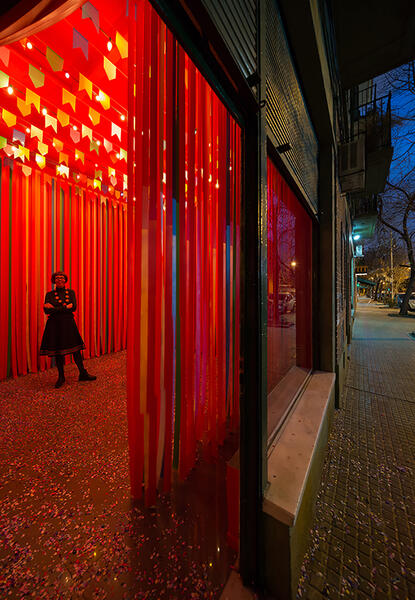Studio R & R: Ceci n'est pas happening. Monoambiente. Buenos Aires
The exhibition was not a happening but that happened: a project featuring the architecture of emotion rendered as a portable party thanks to the abracadabra that completed the sound decoration.

If dreams and happiness are two of the most potent driving forces of desire, obtaining an instrument that captures these intangible elements might be listed as the most complex and sublime endeavor, the challenge for a metaphysical architecture.
The native cultures attempted to achieve this through the dream catchers, objects that operate on a vertical plane assuming that dreams circulate like air. With a heterogeneous contemporary background, the work Instant Happiness – first incursion of the R & R studio in Argentina – doubled this wager: a threedimensional object capturing the multiple stimuli that compose joy, a little box of happiness designed to host people, activated through spatiality, color and movement.
The smell of polymer – half stimulating, half soporific – reaches the sidewalk and goes well into the street, where people chat, laugh, drink and seem to undulate with gentle movements in a corner of the Buenos Aires neighborhood of Chacarita. From the nocturnal corner one may catch a glimpse of a party, on one of the sides of the mythical Los Andes neighborhood, historical witness of the origin of workers’ housing in Argentina. The brick wall reinforces the colorful daydream that emanates from Monoambiente, designer Martín Huberman’s small gallery.
With the same ease that characterizes his editorial edition, Tomás Powell curated Ceci n’est pas happening, the show that was not a happening but that happened: a project featuring the architecture of emotion rendered as a portable party thanks to the abracadabra that completed the sound decoration. In the scant 20 square meters of this microgallery, Powell articulated a project that he manages to explain through the etymological coincidences of the words happening and happiness starting from the word hap (luck or chance, the possibility of something coming to pass). “In the AngloSaxon world, happiness is closely linked to the possibility of things happening; a reading that is especially true in the case of activities involving projects”, he points out.
The approach and scope of the R & R studio, based in Miami and composed of the architects and visual artists Rosario Marquardt and Roberto Behar, is difficult to classify. Capable of designing dainty spaces and situations for a museum, a gallery, a square or an urban enclave, R & R ‘s transdisciplinary imaginaries stimulate nerve centers of the emotional social memory, as if they practiced social acupuncture on art, architecture and urban planning. “What we create are sorts of souvenirs of an alternative world still to be built,” they say. Navigators of a considerable background, the impulse of Gastón Breyer’s heuristic training of the 1980s in Argentina shines again in this nomadic proposal, which embodies a utopia with the possibility of growing and reaching the public sphere: a party presented as an assemblable kit. The leit motiv of the plastic band curtains, which the duo has artisans make for them in colors they have christened Racing light blue or Mexican pink, reappear. The Buenos Aires exhibition features 2,000 meters of plastic bands that mark the perimeter of the space and brush the viewers’ bodies: a fabric that memory records on the skin as associated to butcher’s shops, storehouses and summers, when they are used to keep out the heat and flies. Memories are lit by the charity fair genealogy of light bulbs and streamers, icons of popular decoration. In Instant Happiness, confetti and music impart movement to the curtain perimeter; a cheerful round of meetings in the space conjures the spirit of what finally happens: an analogical, ultra pop and low tech party. Under the concept of musical decoration, Soledad Rodríguez Zubieta (a.k.a SRZ) controlled the sound dimension by resorting to a playlist of unbeatable dance hits: from Hercules Love Affair to Charly García, sound spanned a considerable part of the 20th and 21st centuries, reinforcing the idea put forth by Remo Erdosian – Roberto Arlt’s character in Los siete locos – that hovers over the project: “Happiness is the most important thing.”




